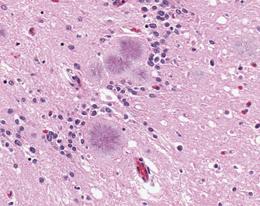Metal wires 'catalyse' appearance of rogue proteins from healthy brain tissue.
 Prions are implicated in conditions such as variant Creutzfeldt-Jakob disease, where brain tissue is damaged, as shown here.Teresa Hammett/CDC
Prions are implicated in conditions such as variant Creutzfeldt-Jakob disease, where brain tissue is damaged, as shown here.Teresa Hammett/CDCAfter an epic series of experiments, a group of researchers has observed and reproduced what could be the spontaneous generation of prions — rogue misfolded proteins that have been implicated in the destruction of the central nervous system.
These misfolded proteins, the culprits in Creutzfeldt–Jakob disease and scrapie, are highly infectious. Although famously transmitted by the ingestion of infected meats, prions are also thought to arise spontaneously in a tiny fraction of humans and other animals. Such de novo prion generation has previously been achieved with animal cells using a method called 'protein misfolding cyclic amplification' (PMCA), which involves repeated rounds of ultrasound and incubation.
Now, a London-based team reports observing prions appearing from healthy mouse brain tissue1. (Human samples have traditionally proved less amenable to PMCA, and the misfolding of prion proteins is believed to occur at a much lower rate in humans than in mice.)
"What we were doing was trying to develop a very sensitive assay for prion detection on a metal surface, so we could use that in prion decontamination," says co-author John Collinge, who heads up the Department of Neurodegenerative Disease at University College London.
"It took a while before we could convince ourselves this was a real phenomenon."
Sticky steel
Prions readily bind to steel wires, which can thus be used to detect the presence of prions, as well as to infect brains in laboratory studies. Collinge suggests that the metal surface in the team's experiments somehow catalysed the formation of prions.
While working on a mouse version of scrapie in Collinge's lab, the researchers found that some wires coated with uninfected mouse brain, intended to serve as controls, tested positive. Eventually, they concluded that this was not an error or a result of contamination.
In a typical experiment, they report, wires were placed with brain homogenate from either uninfected mouse brains or brains infected with scrapie prions. Out of 16 experiments, 9 had controls that were positive for prions. In total, 40 of 2,268 wells on test plates were positive.
The authors even went to the precaution of repeating the study in another laboratory that had never been used for prion work. They purchased new equipment and had it shipped directly to the site to avoid any risk of contamination. Despite this, healthy, uninfected brain cells still tested positive for prions at low rates.
"We can reproduce in a system in a lab what people believe is happening in animals and humans," says co-author Charles Weissmann, who is currently studying prion biology at Scripps Florida in Jupiter.
"In the beginning it was pretty hard to believe. We spent years repeating the experiment under more and more strenuous circumstances."
Crucially, when transferred to mice, the new prions caused disease with different characteristics from that produced by the scrapie prions normally used in the laboratory.
"Indeed, the histopathology associated with 'spontaneous prions' was unlike any seen previously in our laboratory," the paper notes. "The distinctive histopathological pattern elicited by the spontaneous prions excludes contamination with RML [Rocky Mountain Laboratory] or other mouse-adapted scrapie strains used by us as a cause for these mouse transmissions."
What's the alternative?
There is an alternative explanation to that of spontaneous generation.
Prions are believed to be a polymer of misfolded proteins. Collinge says that nascent 'seeds' of prions might be forming and being destroyed in brains all the time. The metal wire could have the effect of concentrating seeds, thus increasing the rate at which prions form.
"What will be important now will be distinguishing whether this low abundance does exist, or whether the process induces the spontaneous generation of prions," says Claudio Soto, an expert in neurodegenerative disorders at the University of Texas Medical Branch in Galveston who was not involved in the work.
Soto's team pioneered the PMCA method — initially as a way of detecting prions, but later as a potential way of generating them. "It seems to me the possibility normal tissues have a low abundance of prions is quite feasible," Soto says.
Distinguishing between these two possibilities is the crucial next step. If pre-existing prions are being concentrated on the steel wires, the rate at which this happens should be directly proportional to the concentration of the brain material. More brain equals more seed prions. Conversely, genuine spontaneous generation would be a higher-order function of concentration, the authors note2.
References
- Edgeworth, J. A. et al. Proc. Natl Acad. Sci. USAdoi:10.1073/pnas.1004036107 (2010).
- Eigen, M. Biophys. Chem. 10, A1-A18 (1996).
Nenhum comentário:
Postar um comentário